
Sample Lesson Template
- Subject:
- Career and Technical Education
- English Language Arts
- Material Type:
- Lesson Plan
- Date Added:
- 04/25/2016
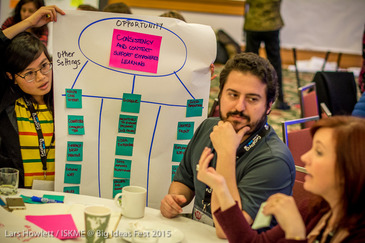

Sample Lesson Template
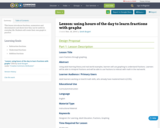
This lesson introduces fractions, numerators and denominators and shows how they can be useful in everyday life.
Students will create their own graph to practice.
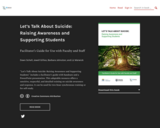
Facilitator’s Guide for Use with Faculty and Staff
Short Description:
"Let’s Talk About Suicide: Raising Awareness and Supporting Students" includes a facilitator’s guide with handouts and a PowerPoint presentation. This adaptable resource offers a sensitive, respectful, and detailed training on suicide awareness and response. It can be used for two-hour synchronous training or for self-study.
Long Description:
Let’s Talk About Suicide: Raising Awareness and Supporting Students includes a facilitator’s guide with handouts and a PowerPoint presentation. This adaptable resource offers a sensitive, respectful, and detailed training on suicide awareness and response. It can be used for two-hour synchronous training or for self-study. It was developed to reduce the stigma around suicide and to help faculty and staff acquire the skills and confidence to ask if a student is considering suicide, listen to that student in a non-judgmental way, and refer the student to appropriate resources. This resource was created to be accessible, adaptable, culturally located, evidence-informed, inclusive, and trauma-informed.
Word Count: 25059
(Note: This resource's metadata has been created automatically by reformatting and/or combining the information that the author initially provided as part of a bulk import process.)
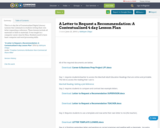
This is a 4-day Set of Contextualized Digital Literacy Lessons that culminate in students writing their own letter requesting a reference. These lessons include all materials or links to materials. It was taught in a computer career class for ELLs. Students need to have basic computer and word processing skills.

Second Edition
Short Description:
This resource is one of twenty-three competencies that make of Trades Access Common Core (TACC). After completing this competency, students should be able to use effective study habits; effective listening techniques; effective note-taking techniques; techniques for reading textbooks effectively; ways to research materials; and effective techniques for preparing for and taking notes.
Word Count: 13897
(Note: This resource's metadata has been created automatically by reformatting and/or combining the information that the author initially provided as part of a bulk import process.)
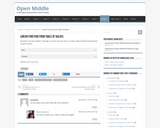
This Open Middle task asks students to create a table of values that represents a linear function.
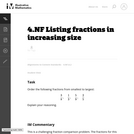
This is a challenging fraction comparison problem. The fractions for this task have been carefully chosen to encourage and reward different methods of comparison.
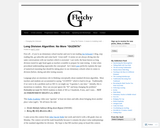
In this blog post and the included lesson plan, Graham Fletcher and Joe Schwartz explore thinking conceptually about the standard division algorithm. In his lesson, Joe Schwartz scaffolds long division using tape diagrams.
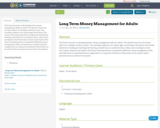
This lesson focuses on developing basic money management skills for adults. The specific time focus for these skills is on multiple months to years. The intended audience is for adults ages 18 and above.The lesson will include elements of reading and writing and listening, and will focus on authentic texts, videos, facts and figures cited from expert research and reports.This lesson will help learners comprehend different money management skills, and help them to understand how to apply them in a long term timeframe.These skills can be used in both a personal sense as well as for business.
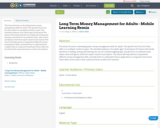
This lesson focuses on developing basic money management skills for adults. The specific time focus for these skills is on multiple months to years. The intended audience is for adults ages 18 and above.The lesson will include elements of reading and writing and listening, and will focus on authentic texts, videos, facts and figures cited from expert research and reports.This lesson will help learners comprehend different money management skills, and help them to understand how to apply them in a long term timeframe.These skills can be used in both a personal sense as well as for business.
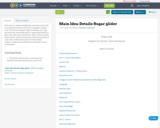
This lesson is aimed at finding the main idea and details in an informational text. The text is at grade C reading level. The learner should be able to identify, sort, state and write the central idea and it’s supporting details in a given text. The terms central idea, theme, thesis, mainly about, will be used as synonymous with the main idea of a text. The students will create a brochure/flyer, conduct research and build fluency during the course of this lesson.

This module is intended for students who are working to acquire their GED. The reading level is Level C which is 4-5th grade with a high interest reading for students who enjoy cars. This is intended for a class lesson or one on one instruction. There are interactive, independent, reading, writing and speaking components.
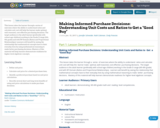
This lesson takes the learner through a series of exercises where the ability to understand ratios and calculate unit cost will help the learner make optimal, well-reasoned, cost-effective purchasing decisions. The target audience is the adult learner (preferably with school-age children) working in the Grade D range (6th-8th grade) and with RP Domain (Ratios and Proportional Relationships). Learners will benefit by seeing the relationship that mathematical concepts have to their everyday lives by using mathematical reasoning to make better purchasing decisions. Mastery of this material will help learners demonstrate readiness for higher-level algebraic concepts.
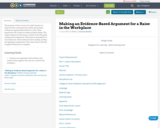
The purpose of this course is for adult learners to improve their communication skills, particularly writing, by arguing effectively for a raise. Their arguments will consist of evidence-based claims. The target audience of this lesson is adults at the 7th grade reading and writing level. This lesson is intended for a real classroom. This module involves reading, writing and speaking components. The entire lesson will take roughly 30 minutes to complete.


Getting Started
Type of Unit: Introduction
Prior Knowledge
Students should be able to:
Solve and write numerical equations for whole number addition, subtraction, multiplication, and division problems.
Use parentheses to evaluate numerical expressions.
Identify and use the properties of operations.
Lesson Flow
In this unit, students are introduced to the rituals and routines that build a successful classroom math community and they are introduced to the basic features of the digital course that they will use throughout the year.
An introductory card sort activity matches students with their partner for the week. Then over the course of the week, students learn about the lesson routines: Opening, Work Time, Ways of Thinking, Apply the Learning, Summary of the Math, and Reflection. Students learn how to present their work to the class, the importance of taking responsibility for their own learning, and how to effectively participate in the classroom math community.
Students then work on Gallery problems to further explore the program’s technology resources and tools and learn how to organize their work.
The mathematical work of the unit focuses on numerical expressions, including card sort activities in which students identify equivalent expressions and match an expression card to a word card that describes its meaning. Students use the properties of operations to identify equivalent expressions and to find unknown values in equations.

Students discuss as a class the important ways that listeners contribute to mathematical discussions during Ways of Thinking presentations. Students then use the properties of operations to find the value of each fruit used in equations.Key ConceptsStudents use the properties of operations to find the value of each fruit used in different equations. By considering several equations, students can match each of the 10 fruits to the whole numbers 0 through 9. This work helps students see why representing unknown numbers with letters is useful.Goals and Learning ObjectivesContribute as listeners during the Ways of Thinking discussion.Identify the whole numbers that make an equation true.Use the properties of operations, when appropriate, to justify which whole numbers represent unknown values.
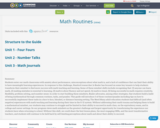
Students enter our math classrooms with anxiety about performance, misconceptions about what math is, and a lack of confidence that can limit their ability to have meaningful learning experiences. In response to this challenge, Stanford researcher Jo Boaler has focused on some key tenants to help students transform their mindset to find more success with math teaching and learning. Some of these mindset shifts include recognizing that: (1) anyone can learn math, (2) making mistakes is essential to learning, (3) math is about fluency and not speed, (4) math is visual, (5) being successful in math requires creativity, flexibility, problem solving, and number sense.
In order to start building these mindsets, Boaler advocates, among other strategies, that students build a habit of being mathematical through common routines, tasks, and puzzles.
This guide will introduce 3 of those routines/puzzles including tips on how to successfully implement these tasks in a face to face, blended, or distance learning setting.
The Need
Many adult education students had difficult (and often negative) experiences with math teaching and learning during their time in the K-12 system. Without addressing their math trauma and helping them to build a mathematical mindset, our students may continue to struggle and be limited in their ability to succeed in math class, on the equivalency exam, and in college and career settings. So our program views math mindsets as the greatest challenge and largest opportunity for transforming the experience our students have when returning to school. Without this shift, we could share the best lesson plans, the most engaging OERs, and the most transformative teachers, and students will continue to be held back by self-limiting perceptions about math and about their ability to succeed.
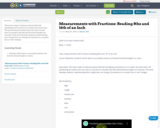
This lesson helps to build procedural skill with identifying unit fractions on a number line (and ruler). The partitioning of number lines and rulers is used here to introduce the idea that fractional lengths are invariant. This work develops students' understanding that a length does not change if its position on a number line or ruler changes.
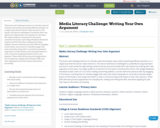
This lesson will challenge learners to critically read and evaluate news articles presenting different positions on a single issue that the learner takes interest in. The learner will then be challenged to formulate their own opinion by refining their own argument on the issue. The target audience of learners for this lesson constitute the Career and College Readiness Standards Grade Level E (9-12) in their reading and writing abilities. Learners will hone practical skills by engaging in this lesson, such as how to critically engage with news and media, being able to succinctly summarize larger pieces of information, and using information to write a structured argument based on their own opinions. These skills will have practical applications for everyday life, reading and writing the GED, and when applying for jobs that require information processing.